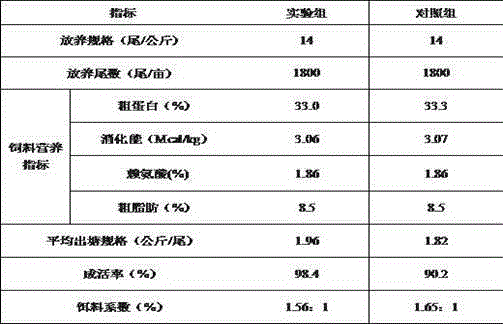Feed capable of preventing liver and gallbladder syndromes of crucian carps under high-density raising conditions
A high-density technology for hepatobiliary syndrome, which is applied in aquaculture feed and feed for prevention of crucian carp hepatobiliary syndrome, can solve problems such as the impact of sustainable development of the aquaculture industry, the threat to farmers' economic interests, and the feeling of edema in the fish body. , to achieve the effect of promoting fat conversion and protein digestion and absorption, improving production level and economic benefits, and promoting cell membrane rupture and autolysis
- Summary
- Abstract
- Description
- Claims
- Application Information
AI Technical Summary
Problems solved by technology
Method used
Image
Examples
Embodiment
[0014] Embodiment: produce 1000 kilograms of feed of the present invention, at first get following raw material and additive: 150.0 kilograms of wheat, 130.0 kilograms of rice bran, 100.0 kilograms of distiller's grains of corn, 150.0 kilograms of soybean meal, 62.0 kilograms of cottonseed meal, 56.0 kilograms of rapeseed meal, 20.0 kilograms of rice protein powder kg, imported fish meal 210.0 kg, meat and bone meal 40.0 kg, soybean oil 20.0 kg, phospholipid oil 15.0 kg, calcium dihydrogen phosphate 17.0 kg, salt 2.0 kg, choline chloride 2.0 kg, 65% lysine 2.0 kg, calcium hydroxymethionine 2.0 kg, 1.0 kg of Vc phosphate, 1.0 kg of allicin, 1.5 kg of Bupleurum, 1.5 kg of Citrus aurantium, 1.2 kg of capillary, 2.0 kg of licorice, 0.8 kg of Magnolia officinalis, 1.0 kg of rhubarb, 1.0 kg of woody fragrance, 1.0 kg of tangerine peel , vitamin A0.025 kg, vitamin C0.25 kg, vitamin D30.02 kg, vitamin E0.25 kg, vitamin K30.03 kg, vitamin B10.02 kg, vitamin B20.02 kg, vitamin B60.03 kg,...
experiment example
[0016] Experimental example: adopt the feedstuff that above-mentioned embodiment produces to feed crucian carp and carry out comparative test, experiment group and control group are pond mouth 80 mus together, and every mu puts in fry weight is 14 per kilogram, and every mu of water surface puts in a suitable place to breed 1800 tails, supporting in a suitable place to breed There are 55 silver carp and 30 silver carp. In late August, 400 crucian carp will be thinned out once per mu. In mid-April, crucian carp was fed according to the conventional feeding method. When the water temperature rose above 22°C, the experimental group was fed every 15 days as a cycle. The conventional feed was fed continuously for 11 days, and then the present invention was fed continuously for 4 days. 4-5 cycles; after that, the conventional feeding method was used to feed the conventional feed until November; the control group chose the same conventional feed as the experimental group, and the cruc...
PUM
 Login to View More
Login to View More Abstract
Description
Claims
Application Information
 Login to View More
Login to View More - R&D
- Intellectual Property
- Life Sciences
- Materials
- Tech Scout
- Unparalleled Data Quality
- Higher Quality Content
- 60% Fewer Hallucinations
Browse by: Latest US Patents, China's latest patents, Technical Efficacy Thesaurus, Application Domain, Technology Topic, Popular Technical Reports.
© 2025 PatSnap. All rights reserved.Legal|Privacy policy|Modern Slavery Act Transparency Statement|Sitemap|About US| Contact US: help@patsnap.com

